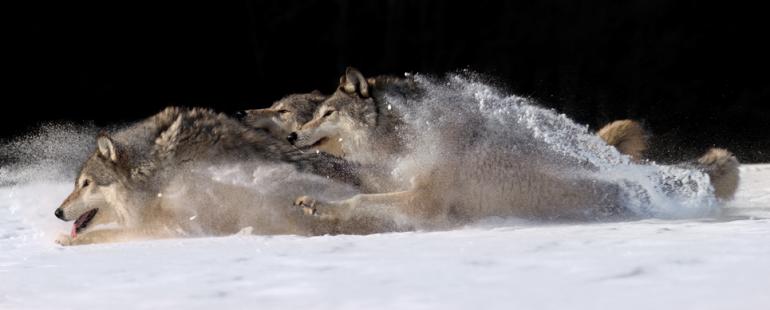A New Season
Barring judicial intervention, on September 15 the State of Montana is set to begin its first-ever hunt of gray wolves as a species in need of management, hunted in a fair-chase manner much like big-game species. Their presence today in the state is a long story for a species that was bounty hunted and likely extinct as a self-sustaining population in Montana by the 1930s. The species gained legal protection in the lower 48 states in 1974.
Today in Montana, under those protections and with reintroductions in 1995 and 1996 to the Greater Yellowstone and Central Idaho Areas, wolves are thriving. By the end of 2008, there were an estimated 497 wolves (34 breeding pairs) distributed primarily across western Montana. Wolves were delisted from the Endangered Species Act in May 2009.
In many ways, the return of the gray wolf to Montana is a conservation success, which for some begs the question: why would we want to hunt them?
The answer has several facets: biological, social-political, and ecological. Biologically speaking, compared with other large carnivores, wolves are relatively productive. Although females can give birth only once a year, in northwest Montana for example, litter sizes range from 1 to 9 with a mean of 5.3 pups. Other large carnivores attain reproductive maturity later, have smaller litters, and don’t reproduce annually. In Montana, the primary tool used to manage big-game population size is hunter harvest. Land-use and wildlife-management conflicts are expected if the wolf population grows unchecked.
Fitting the species on today’s landscape will require proactive management to balance conflicts with other values such as maintaining wild prey species like deer and elk at levels that are both biologically and socially acceptable. In addition, as wolves repopulate across a broader landscape, they may also come into conflict with people. In areas such as the Big Hole or Madison Valleys of southwest Montana, for example, wolves occasionally kill livestock.
State and federal personnel (and under certain circumstances private citizens), lethally remove wolves if they are caught threatening or killing livestock. While these management activities will continue, targeted hunter harvest may alleviate the need for some of these actions. Part of the deal of returning a predator species likes wolves to the landscape is maintaining a balance of values: wolves appreciated as a species and part of the ecological fabric on the landscape (and what comes with that appreciation in the form of tourism, for instance) alongside other values such as livestock production and elk-hunting opportunity.
Hunters are the ultimate wildlife advocates. In Montana mountain lions, elk, and other species enjoy unquestionable support by most people who hunt them. For example, it is quite common for lion hunters in Montana to seek more conservative quotas for lion hunting in order to ensure their long-term health. Hunters appreciate their quarry for all kinds of reasons: the inherent value of the animal on the landscape, the skill and physical abilities hunters require to pursue such an animal, the ability of an animal to use its habitats and survive pursuit, beating the odds and drawing a limited license, the trophy value. All of these reasons contribute to strong advocates, deep appreciation, and ultimate value for the species itself. Wolves don’t yet have this kind of deep support from some hunters, although over time it is hoped that the species will gain it through hunting opportunities.
The Montana Fish, Wildlife & Parks Commission adopted a conservative quota for the state’s first wolf hunt. For a combination of reasons, the Commission decided to adopt a “take it slow” approach in order to learn from experience. No one knows at this point how successful Montana hunters will be, short of gleaning clues from other areas that have hunted wolves. In the end, Montana will learn over time as it has with other game species.
Thus, there are many reasons to hunt wolves now. Commitment to long-term conservation and management of a species (which often includes hunting), whether it’s elk, moose, bear, or wolf, designates more value to that species. Montanans have shown that commitment any number of times over the last century and are now continuing that commitment with the wolf.
Melissa Frost is the information and education manager for region 3 of the Montana department of Fish, Wildlife & Parks.






